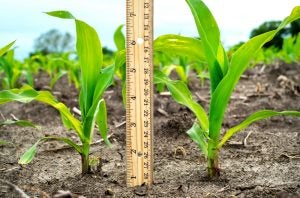A fungus that can colonize, or grow within, corn plants doesn’t just leave the plant unharmed — it also can help the plant stave off harmful bugs and other fungi, according to a new study by Penn State researchers.
In the study, the College of Agricultural Sciences researchers studied the effects of the fungus Metarhizium robertsii on corn. They found that when the fungus colonized corn, the plants were less vulnerable to the effects of another fungus, C. heterostrophus, which causes the disease southern corn leaf blight.
They also found that corn plants grown from seeds treated with M. robertsii grew to be taller and heavier than plants grown from untreated seeds.
Mary Barbercheck, professor of entomology, said the findings — recently published in PLOS One — suggest that M. robertsii could be an important tool in growing a crop and helping it stave off disease, especially for organic growers.
“There’s been a lot of interest recently in biological products to put on seeds or plants either to replace or complement synthetic chemicals,” Barbercheck said. “These findings could potentially be used to help develop a treatment to apply to plants or to treat seeds before they’re planted. This could then help promote growth and protect the plants from pests and disease.”
According to the researchers, M. robertsii is a fungus that scientists have studied for hundreds of years as a way to control insects. But while researchers knew that the fungus could infect insects and kill them, it wasn’t until about a decade ago that they discovered the fungus was also an endophyte — an organism, such as some bacteria and fungi, that lives within plants without harming them and also potentially can benefit them.
Meanwhile, Barbercheck said there is a large demand for organic livestock products in the U.S. For example, if chicken is going to be labeled as “organic” in the grocery store, it would have needed to consume organic feed, such as corn, throughout its life. For corn to be considered organic, growers must use primarily “physical, mechanical and biological” ways to control pests, weeds and diseases, according to the U.S. Department of Agriculture.
“For grain growers, there are virtually no economical pesticides that they can use,” Barbercheck said. “We were interested in how we can foster the plant’s own ability to tolerate or fight off pests and diseases, and here is this fungus that is common in agricultural environments that we thought might have other benefits, too.”
To test their hypothesis, the research team applied M. robertsii spores to corn seeds before planting both treated and untreated seeds in a greenhouse. Once the seedlings were large enough to have sprouted three or four leaves, the scientists applied C. heterostrophus — the fungus that causes southern corn leaf blight — to both the treated and untreated plants.
Four days later, they measured the seedlings’ height, biomass above the ground, colonization of the plants by M. robertsii and severity of southern corn leaf blight infection.

The researchers found that 74 percent of plants whose seeds had been treated with M. robertsii spores were colonized successfully by that fungus. The maize grown from M. robertsii-treated seeds had less severe southern corn leaf blight, as well as greater height and above-ground biomass, than plants grown from untreated seeds.
Barbercheck said that in the future, she and her colleagues will continue to explore how the fungus interacts with corn — for example, how environmental conditions, such as soil moisture, impact its effects.
“As climate change affects the frequency of droughts and flooding, we want to see how different environments could change how this fungus colonizes and benefits corn,” Barbercheck said. “The research reported in this paper took place under ideal conditions in the lab and in a greenhouse, so we want to take that next step examining it in different environments.”
Imtiaz Ahmad, former postdoctoral research scientist at Penn State; María del Mar Jiménez-Gasco, professor of plant pathology; and Dawn S. Luthe, professor of plant stress biology, also participated in this work.
The U.S. Department of Agriculture’s National Institute of Food and Agriculture and its Organic Transitions program helped support this research.
»Related: Penn State Scientists are cracking the plant epigenetic code


